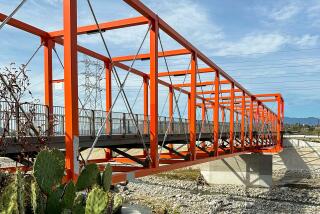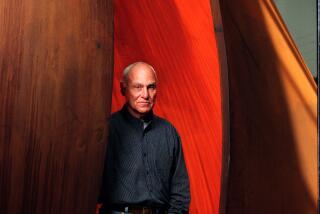Atlanta’s new arch raises a few eyebrows
ATLANTA — On a sunny morning in June, Rodney Cook Jr. stood atop an 82-foot limestone arch embellished with Latin inscriptions and bronze sculptures, waving a salmon-striped shirtsleeve at the panorama below.
“Imagine this as something lovely, like the Royal Crescent in Bath,” the genteel philanthropist enthused, pointing at the flat concrete roof of a row of new apartments. Just beyond were a squat IKEA warehouse, a parking lot and a 150,000-square-foot Target. “Imagine!”
Cook, 51, the descendant of one of Atlanta’s oldest families, has long dreamed of bestowing a more classical architectural style upon his Southern hometown.
Friday, he unveiled the Millennium Gate, a grand homage to the Arch of Titus with a plaza lined with a curving colonnade and a sculptural allegory celebrating peaceful accomplishment over the last 2,000 years.
The $20-million structure, privately funded by Atlanta philanthropists, is the largest classical public monument built in the United States since the Jefferson Memorial opened in Washington in 1943.
It sits just off the 16-lane freeway that courses through Midtown Atlanta, soaring above a small retention pond in the city’s biggest mixed-use development.
Yet it seems almost miniature when viewed against the backdrop of a shimmering 26-story glass hotel tower. From another angle -- in front of a Starbucks -- the yellow IKEA logo peeks through the arch. Some are already calling it the “Arche d’IKEA.”
Americans have long approached public monuments with unease, and the Millennium Gate is no exception. Although Cook says he just wants his city to exude a little more charm, critics wonder whether it’s possible to successfully graft a classical monument onto the mishmash of glossy skyscrapers, concrete parking lots and squat strip malls of Atlanta.
As the structure rose, it inspired 18 pages of comments on the online architecture forum Skyscraperpage.com. Aghast residents described it as a “mock homage to bombast” and a “kitschy McMonument that bespeaks a cultural inferiority complex for all the world to see.”
“It’s like Berlin building a half-size replica of a pyramid in 1880,” railed a blogger. “Why?”
Within contemporary American architectural circles -- where many are concerned about declining infrastructure, inadequate transportation and retrofitting of buildings to make them more energy-efficient -- there is deep suspicion of neoclassical monuments.
“Do we really need that kind of grandeur?” said Kirk Savage, associate professor of history of art and architecture at the University of Pittsburgh. “It’s a little self-defeating to represent your city moving forward into the future with a nostalgic return to the past -- especially if it’s a past that never really existed in the first place.”
Growing up in a mansion in the city’s wealthy enclave of Buckhead, Cook spent hours creating tiny replicas of famous buildings from Paris and Rome.
“People say this city is a young city -- it’s not,” he said. “It’s approximately 175 years old -- I know 50 is supposed to be the new 40, but please! This city is at the point of maturity now. “
Cook did not go to architecture school -- he worried he would come out a Modernist -- but he has long had designs on Atlanta’s public space.
In the early 1990s, he proposed building a lavish Beaux Arts plaza in Atlanta to celebrate the 1996 Summer Olympics. He attracted donors, but the city’s Urban Design Commission decided against the project after local architectural experts ridiculed his designs.
In 1996, he secured funds from Prince Charles’ architectural fund to build the World Athletes Monument, a 55-foot-tall work featuring five bronze sculptures holding up a globe.
Not a decade had passed, however, before there was talk of moving the monument. In 2004 a developer approached Georgia’s Department of Transportation to discuss relocating the sculpture to make way for a new development. Cook wrote an impassioned editorial in the local newspaper; the monument remained.
The Millennium Gate was initially planned as a $50-million arch for Washington’s Barney Circle, but it was moved to Atlanta after enthusiasm in the capital waned after the Sept. 11 attacks.
Unlike many of the heroic arches that inspired it, the monument does not celebrate military victory. According to the website of the National Monuments Foundation, of which Cook is president, it is “first and foremost . . . a work of art.” But it is also a “cutting-edge educational tool,” which tells a “threefold story” of peaceful accomplishment since the birth of Christ, the ascension of the United States and Atlanta’s resurgence as a “giant, globally important city.”
To this end, Cook built a 12,000-square-foot boutique museum of Georgia history inside the arch, featuring displays compiled by the Atlanta History Center, as well as Indian pottery and British Colonial porcelain donated by local philanthropists. The project began with much fanfare, with public officials such as Georgia Gov. Sonny Perdue and Mayor Shirley Franklin greeting the bronze statues after they were shipped from Scotland to Savannah and wheeled through Georgia on a Percheron-drawn caisson.
Yet critics say that however well-executed the monument, scale is everything.
“This city’s monuments are its taller buildings,” said Edward Dougherty, a landscape architect in Atlanta. “It’s a noble effort to create order out of chaos, but it’s hard when everyone’s as independent as a hog on ice.”
About Cook’s hope of bringing the English Palladian style of the Royal Crescent buildings to town, Dougherty said: “This ain’t Bath.”
Even if Atlantans can’t translate the Latin inscriptions or understand the allegorical purpose of the classical figures depicted on the Millennium Gate, many seem to admire it.
“It’s like a mini Arc de Triomphe!” exclaimed John Ziegler, a developer from Gulf Shores, Ala., as he sat in the IKEA parking lot browsing a catalog of kitchen cabinets.
Asked whether that was good or bad, he gave a vigorous nod of his head. “Oh, yeah, it’s gorgeous!” he said.
Upstairs in the IKEA cafeteria, Kathryn Cash, 56, a teacher, said Atlanta was at heart a Southern city, and a classical arch could translate well. “It has that graciousness we aspire to,” she said.
The Millennium Gate may turn out to be an apt monument for the city, expressing the schizophrenia of its rapid development steeped in nostalgic architectural styles. As Cook notes, developers have experimented with a range of classical and vernacular styles in skyscrapers, townhomes, apartments and condos throughout Atlanta.
“Look, none of this is really modern,” he scoffed, leaning against the stucco balcony of his arch to point out the traditional features -- from Roman windows to broken pediments -- of all the new buildings below.
--
More to Read
Sign up for The Wild
We’ll help you find the best places to hike, bike and run, as well as the perfect silent spots for meditation and yoga.
You may occasionally receive promotional content from the Los Angeles Times.







